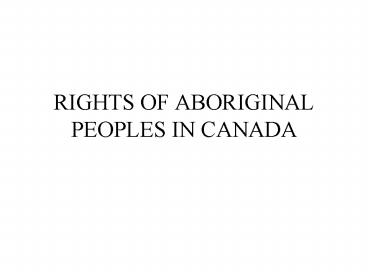RIGHTS OF ABORIGINAL PEOPLES IN CANADA - PowerPoint PPT Presentation
1 / 21
Title: RIGHTS OF ABORIGINAL PEOPLES IN CANADA
1
RIGHTS OF ABORIGINAL PEOPLES IN CANADA
2
Social and Economic Conditions
- Approximately 1.2 million aboriginal people
- Different groups
- Status and non-status Indians
- Metis
- Inuit
- Different living conditions
- Many languages (but dying out)
- Poverty
3
Historical Developments
- Originally treated as nations when European
settlements small and weak. - Later prejudice and discrimination
- Harmful policies
- Isolate on reserves with inadequate resources
- Forced assimilation
- Result Poverty, social problems, high
unemployment.
4
Historical Geographical Differences
- 19th century treaties in most of Canada
- Cases about how to interpret these treaties in a
modern context. - Still no treaties in some areas (British
Columbia) - Means no treaty rights
- But also means land not surrendered
5
Arguments for How Canada Obtained Sovereignty
Over Aboriginal Nations
- Were there aboriginal legal systems?
- If so, how were they (at least partially)
supplanted? - Were they conquered?
- Did Europeans come to unoccupied territory?
- Was there some other mechanism for gaining
sovereignty?
6
Constitutional Framework
- Original Constitution
- Central government given jurisdiction over
Indians and land reserved for the Indians - Central government control instead of control by
provinces.
7
Constitution Act 1982
- 35 (1) The existing aboriginal and treaty rights
of the aboriginal peoples of Canada are hearby
recognized and affirmed. - (2) In this act, aboriginal peoples of
Canada includes the indian, inuit and metis
people of Canada.
8
Constitution Act 1982 Continued
- 25. The guarantee in this Charter of certain
rights and freedoms shall not be construed so as
to abrogate ore derogate from any aboriginal,
treaty or other rights or freedoms that pertain
to the aboriginal peoples of Canada. . .. - We will focus primarily on section 35.
9
Section 35 of Constitution Act 1982
- All Indian, Inuit and Metis people protected.
- Rights protected are those that still existed in
1982. - If they still existed in 1982, they cannot be
abolished now, though there can be some
modification. - Therefore, key question is what existed in 1982.
10
Sparrow case decided test for which rights still
existed
- Claim was immunity from fishing regulations
- Court held the regulations violated his
aboriginal right to fish in that area.
11
Key points in Sparrow case
- Recognition of aboriginal legal systems
- Rights could not be extinguished implicitly
there has to be a clear intent to extinguish. - Rights exist in contemporary form
- Government has trust relation to aboriginal
people. - But aboriginal right can be limited if good
reason to do so.
12
Test for whether a limitation on a right is valid
- Aboriginal people have priority in allocation of
resources like fish. - Justification for a limitation must be
compelling. - Government must take account of the aboriginal
perspective and of aboriginal collective rights. - Case by case approach leaves much undecided
13
Subsequent cases
- Cases imposed new requirements but left the
general principle in place. - Must show engaged in exactly that activity.
- Must show right integral to the society claiming
the right - Must trace to custom that existed before European
contact.
14
Claim to aboriginal title to landDelgamuukw case
- Claim to title to 58,000 square kilometers.
- Court recognized in principle but sent back to
trial to decide facts.
15
Key points in the case
- Existing aboriginal title protected by section
35. - Source of title
- Historical occupation of the land.
- Aboriginal legal systems
16
Characteristics of Aboriginal Title
- Private people cannot buy land. Only the
government can do so. - Ownership is collective, not individual
- Can use land in new ways but not in ways
inconsistent with old ways.
17
How to prove aboriginal title
- Oral histories and stories
- Songs
18
Permissible limits on aboriginal title
- For infrastructure like roads.
- For economic development
- But government must take account of priority of
aboriginal interests - Aboriginal people make no claim to private
property only government land.
19
Factors to consider in deciding whether a limit
on title is justified
- Are aboriginal people given a chance to
participate in the activity? - Was there consultation with them?
- Did they consent?
- Was compensation given
20
Summary
- Aboriginal title recognized.
- But still questions about consequences of this
recognition. - Question whether recognition of aboriginal legal
systems means aboriginal people can claim right
to self-government.
21
Situation today
- Modern treaties in some areas more generous than
19th century treaties - Duty to consult has had important consequences.
- In eastern Canada, cases about modern
interpretation of 19th century treaties - Northern Canada and climate change.
- Cultural conflicts.
- Poverty still a big problem.































